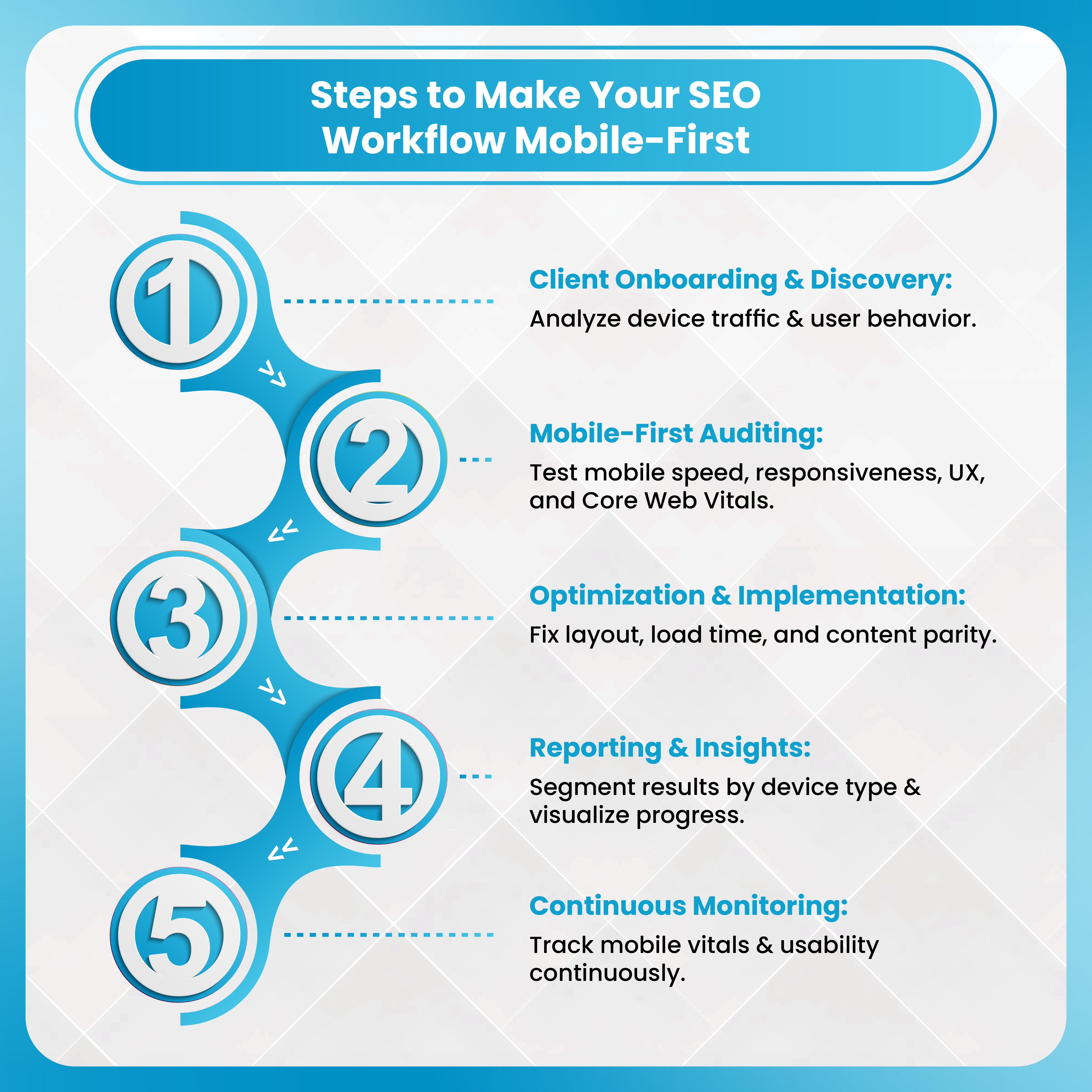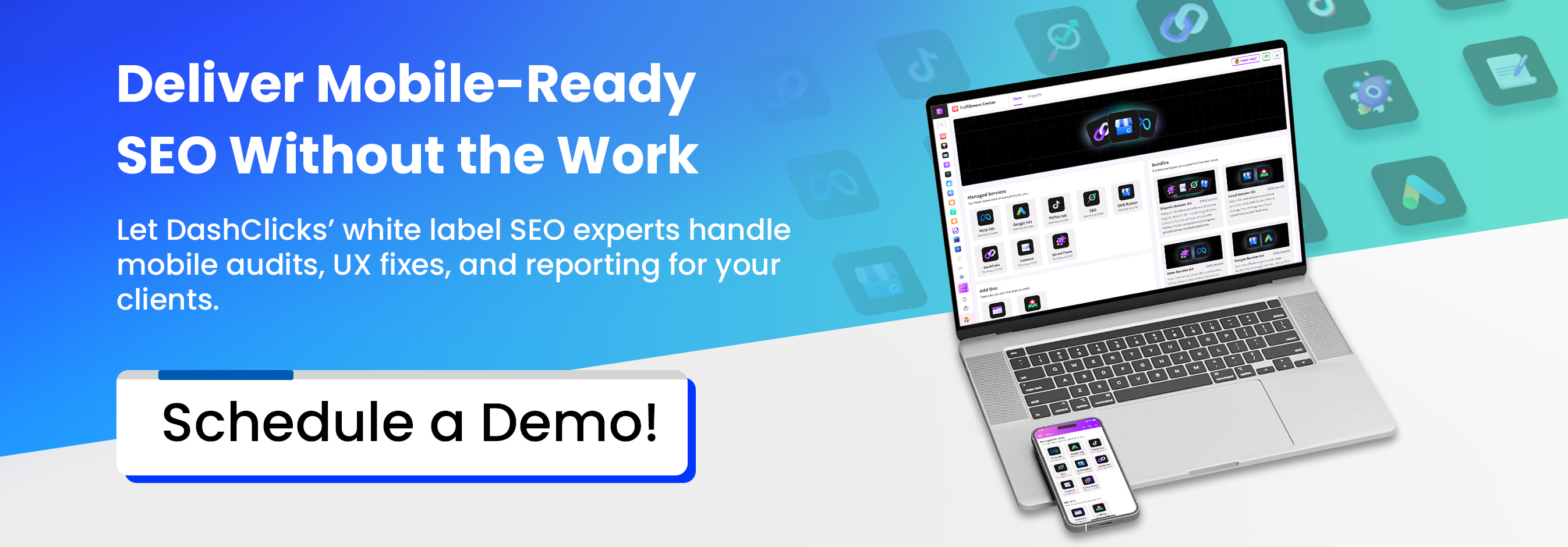Mobile devices have become the default way people access the internet. In 2025, around 64% of global web traffic comes from mobile, according to Statista. That number continues to climb as smartphones become faster and data networks more reliable. For digital marketing agencies, this shift changes everything about how SEO is planned, delivered, and measured.
When Google introduced mobile-first indexing, it signaled a permanent change: the search engine now evaluates and ranks pages primarily based on their mobile version. For agencies offering white label SEO, this means ensuring every client’s site performs flawlessly on mobile isn’t optional—it’s essential.
This blog will help digital agencies understand importance of mobile-first indexing, what to prioritize in audits and workflows, and how a trusted fulfillment partner can help ensure clients rank seamlessly across all devices.
Why Mobile Matters Today?
The dominance of mobile traffic is undeniable. Research by DataReportal shows that mobile devices generate more than 58% of all global web visits, with regions like Asia and Africa seeing even higher shares. In the U.S., over 70% of online time is spent on mobile.
Mobile users also behave differently:
- They expect pages to load within 3 seconds—yet the average mobile load time remains around 8.6 seconds (Think with Google, 2024).
- A 1-second delay in mobile load time can reduce conversions by up to 20%.
- Bounce rates on mobile are typically 10–20% higher than desktop when load times lag or UX is poor.
If an agency ignores mobile optimization, it risks losing both visibility and conversions. Imagine a client whose site gets 70% of traffic from mobile but converts only half as well as desktop visitors—that’s not just a UX problem, it’s lost revenue and potential client dissatisfaction.

Understanding Mobile-First Indexing
Mobile-first indexing means Google primarily uses the mobile version of your site for ranking and indexing. Before this shift, Google mostly crawled desktop versions, but now, if the mobile version lacks key content or structured data, that missing information may never reach Google’s index.
Google began the mobile-first rollout in 2018 and completed it for most sites by 2023. Today, almost all sites are evaluated through mobile-first indexing.
Agencies should ensure:
- The mobile version matches desktop content in quality and metadata.
- Canonical tags and structured data remain consistent across versions.
- The site uses responsive design, not separate m-dot URLs.
In practice, the key question every agency should ask is: “Does my client’s mobile site have feature and content parity with desktop?” If not, rankings are already at risk.
White Label SEO in the Mobile Era?
White label SEO services allow agencies to offer SEO services under their brand while a fulfillment partner handles execution. But in the mobile-first era, the bar for what counts as “SEO-ready” has risen.
A white label SEO partner now needs to:
- Test for mobile responsiveness across multiple devices.
- Audit Core Web Vitals specifically for mobile (LCP, FID, CLS).
- Review mobile navigation, tap targets, and viewport settings.
- Deliver mobile-specific performance reports.
When evaluating fulfillment partners, agencies should ask:
- Do they test sites on real devices?
- Are reports segmented by device type?
- Can they fix or flag mobile-specific errors?
A strong mobile-first partner should provide a complete checklist covering:
- Mobile site load performance.
- Mobile Core Web Vitals scores.
- Navigation and layout usability.
- Page-level issues that affect mobile indexing.
Core Audit Elements for Mobile-First SEO
To perform a thorough mobile-first audit, agencies should focus on two main pillars: technical performance and user experience.
Technical Audit
- Mobile Load Speed: Measure First Contentful Paint (FCP) and Time to Interactive (TTI). Faster is always better.
- Responsive Design: Ensure the layout adapts seamlessly to various screen sizes.
- Viewport & Font Sizes: Proper scaling for readability without zooming.
- Mobile Metadata: Titles and descriptions should not truncate on smaller screens.
- Crawlability: Confirm the mobile version is fully indexable.
Content & UX Audit
- Content Truncation: Avoid hiding key text or rich media.
- Readability: Use shorter paragraphs, adequate spacing, and high-contrast text.
- Touch Elements: Ensure links and buttons are easily tappable.
- Mobile User Behavior: Account for vertical scrolling and thumb-friendly design.
For example, one agency audit uncovered that a client’s hidden mobile filters prevented Google’s smartphone crawler from accessing 40% of the site’s inventory pages. Fixing that boosted visibility within weeks.
How Mobile-First Indexing Affects Ranking Strategy?
Google doesn’t rank sites separately for mobile and desktop—it uses the mobile version as the primary signal. This makes mobile optimization central to all ranking strategies.
Studies show that mobile-friendly sites are 67% more likely to rank in the top three mobile SERPs (SearchMetrics, 2024). Sites with slow mobile load times can drop up to 20 positions on average due to poor engagement metrics.
A client improving their mobile load time from 6 seconds to 3 seconds might see bounce rates fall by 30%, with average rankings climbing accordingly.
Still, desktop traffic remains important, especially for B2B or enterprise audiences. The best white label SEO strategies ensure device inclusivity, optimizing for mobile without compromising desktop experience.
Adapting White Label Workflows for Mobile-First Delivery
To truly deliver mobile-first SEO, agencies need to adapt their white label workflows—not just the strategy itself. That means building mobile awareness into every stage of the process, from onboarding new clients to monthly reporting. Here’s how agencies can align their operations for a mobile-first world.
1. Intake and Discovery
Start with data. During client onboarding, gather insights about how much of their traffic comes from mobile versus desktop. This helps set priorities for optimization. Analyze device-based user behavior, such as session duration, bounce rates, and conversion paths. For instance, if mobile users abandon forms halfway through, it may signal a design or speed issue. These early findings shape your roadmap and let your white label SEO agency focus on the metrics that matter most.
2. Reporting
Generic SEO dashboards no longer cut it. Reports should clearly segment all major performance indicators—traffic, rankings, CTR, conversions—by device type. A good white label SEO partner will provide customizable dashboards that visualize these differences, helping your agency explain where gains are happening. For example, a 15% increase in mobile conversions looks more impressive when shown alongside device-specific benchmarks.
3. Deliverables
Go beyond keyword rankings and backlinks. Request deliverables that directly address mobile performance, such as:
- Mobile UX audits identify layout, navigation, or tap-target issues.
- Mobile load speed reports focusing on compression, caching, and image optimization.
- Mobile link analysis that evaluates how easily mobile crawlers access linked pages.
Also, encourage your white label partner to support mobile-friendly content formats. Whether that means experimenting with Accelerated Mobile Pages (AMP), Progressive Web Apps (PWAs), or simply optimizing layouts for small screens, these deliverables should enhance usability as well as rankings.
4. Continuous Monitoring
Mobile optimization isn’t static—it’s a living process. Set up monthly reviews of Core Web Vitals to track progress and flag regressions. Keep an eye on Google Search Console for mobile usability alerts, which can reveal issues that automated audits sometimes miss.
Some agencies take it a step further by introducing a mobile-first scorecard in every client report. It highlights improvements in speed, responsiveness, and UX, giving clients a clear view of ROI. This kind of transparency strengthens trust and helps justify ongoing optimization budgets.
Adapting your workflow this way doesn’t just make you mobile-ready—it positions your agency as forward-thinking and technically reliable. It shows clients that you’re not just following SEO best practices, but anticipating the next wave of search behavior before it happens.

Key Mobile-First Metrics to Track
Agencies should measure:
- Mobile Traffic Share
- Mobile Bounce Rate
- First Contentful Paint (FCP)
- Cumulative Layout Shift (CLS)
- Mobile Conversion Rate
- Mobile SERP Visibility
Benchmark: According to Soax, mobile now accounts for roughly 64% of all internet traffic globally. If your client’s site is below this ratio, it may signal poor mobile discoverability or performance.
A simple example: when one agency reduced a client’s mobile load time from 5.4 seconds to 3.1 seconds, bounce rate fell by 22%, and conversions rose by 15%—purely from improved mobile performance.
Content and Link Strategy for Mobile
Mobile users scroll differently, read faster, and interact more with visuals. That changes how agencies should create and structure content.
Content Best Practices
- Write concise paragraphs.
- Use vertical media formats and compressed images.
- Prioritize “above the fold” information.
Mobile Link Building
- Focus on local SEO, since about 30% of mobile searches have local intent (Google).
- Ensure linked pages are mobile-friendly and quick to load.
- Target mobile-specific SERP features like featured snippets or voice searches.
For instance, a white label SEO agency like DashClicks can create “quick-answer” pages designed for voice search—ideal for mobile users asking short, conversational queries.
Case Example: Agency-Partner Collaboration
Agency A partnered with a white-label provider to optimize a client’s e-commerce site for mobile-first indexing. Before the project:
- Mobile traffic: 70%
- Average mobile load time: 6.4 seconds
- Mobile bounce rate: 62%
The white label SEO partner:
- Compressed heavy images and scripts.
- Improved Core Web Vitals (FCP down from 4.8s to 2.3s).
- Simplified navigation and improved product filtering for mobile.
- Refined internal linking to match mobile crawl patterns.
After 3 months:
- Load time dropped to 2.9 seconds.
- Bounce rate decreased 15%.
- Mobile conversions increased 18%.
- Rankings improved across multiple product-related queries.
The agency reported strong client satisfaction and used the same playbook for future accounts.
Further Reading: The Impact of White Label Fulfillment on Client Satisfaction in Marketing Agencies
Working With a White Label Partner for Mobile-First SEO
When it comes to outsourcing SEO, not all white label providers are equally equipped for a mobile-first world. Agencies that want to deliver measurable results for their clients need to choose partners who treat mobile optimization as a core strategy, not an add-on.
A capable white label partner should go beyond standard SEO tasks like link building and keyword tracking. They should integrate mobile-first data, tools, and performance benchmarks into every stage of the process—from technical audits to reporting.
Here are key areas to evaluate when selecting a partner:
1. Reporting on Mobile Core Web Vitals
Core Web Vitals—Largest Contentful Paint (LCP), First Input Delay (FID), and Cumulative Layout Shift (CLS)—directly affect how Google evaluates mobile experiences. Ask potential partners whether they track these metrics specifically for mobile users. A strong provider will not only measure them but also include actionable insights in reports that guide development and UX teams toward tangible improvements.
2. Monitoring Mobile Usability in Search Console
Mobile usability issues can quietly undermine rankings even when desktop metrics look strong. Your partner should actively monitor the Mobile Usability section in Google Search Console to identify problems like clickable elements being too close, text too small to read, or content wider than the screen. Ongoing tracking ensures your clients’ sites maintain compliance with Google’s mobile standards as updates roll out.
3. Device-Segmented Deliverables and Data
True mobile-first SEO means understanding that performance varies across devices. A solid partner will segment deliverables and reports by device type—mobile, tablet, and desktop—so agencies can pinpoint where the biggest opportunities lie. For example, they might show that bounce rates are higher on mobile or that certain landing pages load slower on smaller screens.
4. Clear, Measurable SLAs (Service-Level Agreements)
Agencies should look for partners who define performance expectations clearly in their service agreements. For instance:
- “Mobile load time must improve by at least 25% within 45 days.”
- “Monthly reporting must include device-segmented metrics and Core Web Vitals benchmarks.”
These clauses hold partners accountable and ensure consistent progress toward client goals.
5. Continuous Optimization and Adaptation
Mobile-first SEO isn’t a one-time technical adjustment—it’s an ongoing process. Browsers evolve, devices change, and user behavior shifts constantly. A strong white label SEO partner will monitor these changes proactively, adjusting strategies to maintain and improve rankings over time. They’ll also keep testing new mobile technologies, like progressive web apps or responsive design frameworks, to help clients stay competitive.
In short, a reliable white label SEO services provider acts as an extension of your agency—committed to your clients’ long-term mobile performance. Their expertise in mobile-first SEO ensures that every campaign you deliver not only meets search standards today but continues to perform as the web keeps evolving.

Why DashClicks Works for Agencies Focused on Device-Inclusive SEO?
DashClicks gives agencies a complete white label ecosystem built for scalable, mobile-first SEO delivery. The platform combines software, fulfillment, and reporting into one streamlined system.
Here’s how DashClicks supports agencies on the mobile-first front:
- Mobile-First Reporting: Dashboards break down performance by device, making it easy for agencies to present clear data to clients.
- White Label Fulfillment: The white label SEO services handles mobile audits, responsive design fixes, link-building, and UX improvements.
- Automated Workflows: Agencies can launch and monitor mobile-first campaigns for multiple clients without managing every detail.
- Cross-Device Optimization: From Core Web Vitals tracking to content structure checks, DashClicks ensures every site ranks well across screens.
For agencies scaling fast, DashClicks eliminates the complexity of managing technical SEO in-house. You focus on client relationships; they handle the behind-the-scenes optimization—ensuring every client site is mobile-ready and performing across devices.
Common Pitfalls and How to Avoid Them
Pitfall 1: Treating mobile as an afterthought
Fix: Run a full mobile audit before launch and ensure parity between desktop and mobile versions.
Pitfall 2: Ignoring mobile load speed
Fix: Test regularly using PageSpeed Insights and monitor Core Web Vitals.
Pitfall 3: Tracking only desktop metrics
Fix: Use dashboards that segment traffic and performance by device.
Pitfall 4: Partnering with providers that lack mobile expertise
Fix: Vet white-label vendors for mobile experience, case studies, and reporting standards.
Future Trends in Mobile-First SEO and White Label Growth
The mobile landscape is evolving quickly. 5G networks, foldable screens, and voice search are reshaping user expectations. Agencies should expect:
- Increased optimization for voice-based and visual searches.
- Demand for mobile commerce experiences and progressive web apps.
- Growth in white label SEO services with the market projected to rise from $64.4 billion in 2024 to $75.2 billion in 2025.
Staying ahead means building flexible, device-inclusive strategies that work across emerging form factors and connection speeds.
Final Thoughts
Mobile-first indexing isn’t a passing trend—it’s the standard. For agencies, ensuring that clients’ sites perform well on every device is no longer optional. Partnering with a white-label SEO provider that understands this environment is the fastest way to deliver results at scale.
A mobile-first white-label strategy aligns technical SEO, UX, and content under one goal: visibility and conversions across all devices. Agencies that embrace this model will see stronger client retention and faster growth.



.svg)

.svg)
.svg)
.svg)
.svg)
.svg)

.svg)




.svg)
.svg)
.svg)
.svg)
.svg)